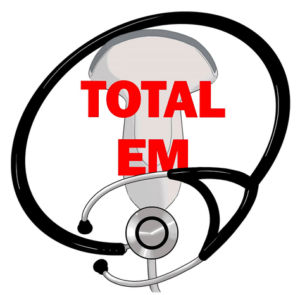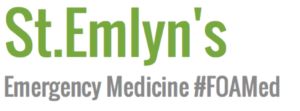Nursing FOAMed Review #3 (Aug 21st – Sept 10th)
Josh Farkas writes for PulmCrit (EMCrit) discussing his thoughts about the IOTA trial, his overall opinion on the sanctity of the meta-analysis, and what it means to judge a trial’s fragility index. When the IOTA trial came out in late April it made a pretty big splash. The trial purported to show that conservative oxygen management was clinically superior (lower mortality) when compared to liberal oxygen administration during treatment of acute illness. Obviously a study that shows we need to ease off the O2 (ahem….. read: pay attention to exact amounts and titrate based on actual physiological needs) was bound to cause a stir. We have previously tended to treat oxygen (at least in the field of nursing) like drug seekers treat Dilauded – the more we up the dose, the better the patient is going to feel! But Farkas is adept at finding the weak spots in any analysis – even a meta-analysis. His write up is great, his conclusions are solid – and he may just have changed some minds as to the inviolability of the meta-analysis.
Rory Spiegel writes again in EMNerd (EMCrit) and gives us The Case of the Needless Imperative. This is another brief review of the literature being thrown around right now concerning airway management during cardiac arrest treatments (pre-hospital in many cases) and focuses on the results of the PART trial and the results of the AIRWAY-2 trial. Both of these articles have shown poor outcomes for the ETT cohorts and have certain airway purists foaming at the mouth. Dr. Spiegel has a pretty measured take on things and it is always nice to hear a respected experts opinion when new data looks like it may start to upset the status quo.
Dr Anand Swaminathan writes for CORE EM about Cauda Equina. Nothing mind-blowing here, but sometime simple is best! This is an important review if you haven’t thought about this differential in a while. All those patients who come in with sciatica and lower extremity pain/weakness need to be asked important differential questions regarding urinary frequency/incontinence. Take a look at the symptom specificity and sensitivity breakdown here, and dive into the review – especially if you haven’t thought about Cauda Equina since nursing school.
Podcast #110 from TotalEM gives us a good literature review on IO access and how the IO drawback can effect our lab values. This is a question that gets thrown around a lot in the critical care bay. “If I get this blood from the IO, can I still use it to send samples down to the lab?” Or, “Can we use this stuff in an iStat POC test?”
This TotalEM podcast references two articles concerning the IO lab results question. Both studies are small (the 2010 study N=10 and the 2017 study N=31), but show that certain lab values on samples drawn from IO are consistently inaccurate. Some of these lab values are vitally important, and may dictate certain emergent treatment protocols (think about elevated serum potassium from an IO in a cardiac arrest patient which would point a resuscitation team to hyperkalemic protocols.) This is a great read (or listen) for those interested in having a more detailed answer next time the question about lab values and IOs is asked.
St. Emlyn’s has my favorite post for this entire FOAMed review with an article by Simon Carley concerning fluid resuscitation. The St. Emlyn’s post is mainly a response to a recent article published in Nature by Simon Finfer, John Myburgh & Rinaldo Bellomo entitled Intravenous fluid therapy in critically ill adults. Simon Carley brings us face to face with one of our most profoundly misunderstood interventions: IV fluids. This has been one of my favorite reads in a long time. Some of the incredible gems within (or at least linked to) Carley’s article:
- Why “normal saline” is anything but normal
- A quick literature review that may explain why you’re giving more LR and less NS recently.
- Why “fill ‘em up and diurese them later” may be more harmful than previously thought.
- Discussion about “buffered salt solutions” vs NS – for a more detailed discussion about the possible benefits of buffered solutions look at the original article hyperlinked above.
All in all, this is a fantastic write up, and I think that it should probably be shared as much as possible amongst any nurse that hangs fluids (everyone, right?). The pathophysiology breakdown concerning hypovolemia and the possible interventions, and how those interventions can be monitored, is truly fascinating. As nurses, we probably give more saline than any other drug. Read this article (and print out and read the original research by Dr. Finfer) if you want to have a better understanding of what it is you are doing to your patient when you hang that liter!
Steve Mathieu writes a great review for The Bottom Line concerning the above mentioned AIRWAY-2 Trial. Per usual with The Bottom Line, there are some amazing PDFs breaking down the results of the trial in true medical algorithm style.
One of the things that I find interesting (and maybe I’m missing something here, so if someone can write back and explain I’d love the assistance) is the survival rate of the patients that received NO AIRWAY adjunct at all and only received BVM intervention. These patients had up to a 25.2% survival rating as compared to 6.4% in the highest survival rating group amongst the SGQ vs ETT groups. I must be reading this wrong. Either that or the obvious results here tell us that we need to ONLY be using BVMs in the field if we care about patient outcomes.
The EM@3AM series from emDocs brings us a review on Ludwig’s Angina. I’ve never had a patient present with Ludwig’s while working in my ED, but I’ve had a few that had symptoms that put Ludwig’s high on the immediate differential – and it is enough to make everyone in the room pretty nervous. If you aren’t familiar with Ludwig’s Angina, it’s presentation or sequelae, this is a great article for you. There is a review of the typical case presentation, as well as the pathophysiology behind that presentation. The biggest takeaway should be that Ludwig’s Angina = airway emergency!! Not only do we need to get the airway cart out and prep for probable RSI, a surgical airway kit needs to be ready. A fair number of these patients require emergent surgical airway management. The other surprise is the high mortality rate these patients experience if not recognized and treated early (while those that are treated properly have a less than 8% mortality).
There is a short reference list at the end of the article as well as a link to a Life In The Fast Lane article that was updated this May if you are interested in a deeper FOAMed dive into Ludwig’s Angina.
Another nerve block technique for migraine headaches? Yup! I don’t know if I will ever really see this technique being used, but new information is always good – even if you don’t think you’ll personally ever use it. Dr David Cisewski at Icahn School Mt Sinai writes about GONB (greater occipital nerve blocks) for pain control in migraines refractory to treatment with Metoclopramide. This study by Dr. Friedman shows that the technique potentially effective in controlling migraine pain – but the study is small (N=28), the intervention seems unlikely to gain traction (Bupivacaine injected around the occipital nerve with sono assistance unlikely unless we want to start shaving heads) especially in emergency departments, as the definition of migraine within the contexts of the study doesn’t necessarily match any particular emergency definition, or restraint on the treatment, of severe headache pain.
Whether you plan on recommending Dr. Freidman’s technique or not, the emDOCS review is a great bit of reading. Dr. Cisewski reviews a formal definition of migraine (something I needed to review for sure) and goes over some standard treatment protocol. It also has a short discussion on the pitfalls of Hydromorphone use for headaches during this modern era of narcotic abuse.
This reminds me of another cringe worthy treatment option for headache brought up in ALiEM back early in 2017. How bad does your head have to hurt to do this stuff?
Leave it to ALiEM to write about Betel Nut. If you don’t know what Betel Nut is, just clink on the hyperlink. I once responded to a patient with a chief complaint of syncopal episode – her husband told us that it was from chewing too much Betel Nut. We spent more time on Google trying to figure out what the heck he was talking about than we spent looking at the patient. Medically obscure as Betel Nut poisoning may be – it is always fun to learn something new.
Dr Evan Kuhl, Natalie Sullivan and David Yamane write for ALiEM concerning resuscitation of a drowning victim. It’s summer and everyones at the beach or in the pool. This review is necessary not only because of timing, it is good information for any resuscitation, ED or CC nurse. The patient presenting with drowning is full of medical truisms – most of which end up as falsehoods the second we reference the literature . Get rid of all the BS and pack in the facts. As they say in FOAMed: it is time for some dogmalysis. Here are some great pearls from this review:
- Dry drowning is not a thing. I repeat – DRY DROWNING DOESN’T EXIST!
- Salt water drowning vs pool water vs bathtub vs brackish??? Nope, nope, nope! Volume of water inhaled into the lungs matters – composition of the water does not seem to have an effect on outcome.
- Isn’t cold water better to drown in than warm water? No. Submersion time is more important to outcome than submersion temperature.
Dive into (ahem… sorry for the pun) this article and go deep with the literature review at the end. 13 articles for your FOAMed leisure.
It really isn’t a FOAMed review without something from CanadiEM right? So here is a write up from those crazy Canadians (and some folks at The Johns Hopkins) about a new paradigm in resuscitation medicine. Introducing the CPR coach during ACLS resuscitation.
The article outlines an interesting concept. Add another team role to the mix – a leader amongst the CPR team that is called the CPR coach. This team role is only responsible for managing the quality of CPR quality during resuscitation. The idea is that the Team Leader can focus on ALS, complex procedures and Hs and Ts, while the CPR coach can focus on fixing our almost universally abysmal numbers related to compression depth, compression fraction, breathing rates, time-off-chest percentages etc etc etc. Some very interesting results in these preliminary studies. Definitely worth a read for those of us interested in resuscitation medicine.
Dr Anand Swaminathan was busy this last month. Not only did he do a quick review of Cauda Equina for CORE EM, but on R.E.B.E.L. EM, he also gets into the controversial results of the recent PRISMS study comparing Alteplase to Aspirin in mild stroke. In his review of this article, Dr. Swaminathan goes back to the results of the NINDS studies that ushered in the modern era of Alteplase use in stroke care. If you aren’t familiar with NINDS, and if you aren’t familiar with the controversy concerning Alteplase, you MUST read this article. While most cursory reviews of the PRISMS trial tend to lean towards Alteplase as the safe method of treatment, R.E.B.E.L. EM puts the onus of proof back on the advocates of Alteplase when he states that multitude of reasons why Alteplase is not necessarily the miracle drug it is treated as within certain circles. Read the review and ask yourself – “If I were having a mild stroke would I want Alteplase or Aspirin? It isn’t as easy a question to answer as some would have you think.
Taming the Sru has a quick review on ED diagnosis of Necrotizing Fasciitis. I’ll be the first to admit that dermatology isn’t my strong suit. But knowing that these patients have a high mortality morbidity, and that nurses are the front line for triaging the vast majority of these patients, I really think that any ED nurse could benefit from reading this review.
One great aspect of this article is the breakdown of the fragility of the LRINEC score system for diagnosis in the ED. Long story short – if you have this score saved under your MDCalc page, you might as well ditch it. The sensitivity is just too low for such a high risk diagnosis. So read the article and find out what to look for. Early recognition and treatment results in better outcomes for these patients! If you have a high index of suspicion for this diagnosis, it might be time to up-triage the patient or ask for a physician consult in the triage area.










